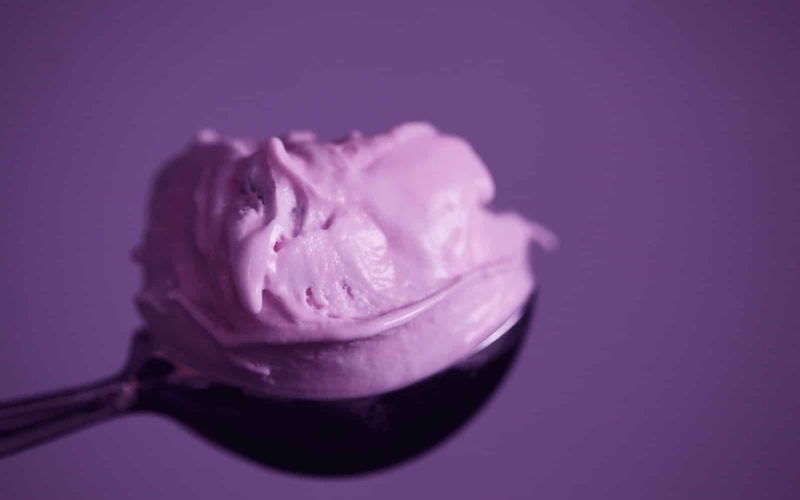Purple foods are often considered exotic or expensive. In reality, they are quite affordable and nutritious.
What are some purple foods that you should try? We will discuss that in this article.
These foods contain anthocyanin, an antioxidant that gives them their color.
Anthocyanin has also been shown to reduce inflammation and improve cardiovascular health.
Purple foods aren’t necessarily bad for you. Some contain antioxidants, vitamins, minerals, fiber, and other nutrients.
Antioxidants are compounds that prevent damage to cells caused by free radicals.
Free radicals are unstable molecules that cause cell damage and can contribute to chronic diseases such as cancer.
Eating purple foods regularly can help reduce the risk of heart disease, diabetes, and cancer.
So now, let’s check out some of these nutritious purple foods.
1. Purple Carrot

Purple carrots are tasty, crunchy veggies containing various polyphenol antioxidants, such as anthocyanins, cinnamic acid, and chlorogenic acid.
According to research, those who consume diets high in polyphenols have lower risks of heart disease, obesity, and diabetes than those who consume diets lacking these vital antioxidants.
Introducing purple carrots into your diet is a smart strategy for improving your health because they contain more polyphenol antioxidants than other carrot varieties.
2. Passion Fruit
Ripe passion fruits have a yellow or purple rind that protects the sweet, velvety flesh filled with crunchy seeds.
Piceatannol, a unique polyphenol antioxidant found in passion fruit, has numerous remarkable health-promoting properties. It may be highly advantageous for skin health.
For instance, test-tube research reveals that piceatannol extracted from passion fruit protected skin cells from solar damage.
In addition, a study on 32 women with dry skin showed that consuming 5 mg of piceatannol for eight weeks improved skin hydration.
3. Purple Mangosteen
As its name implies, purple mangosteen is among the purple-colored foods. Mangosteens have a hard, dark purple peel on the outside that must be removed to eat the sour, slightly sweet fruit inside.
They are a great source of fiber and folate, a B vitamin crucial for many bodily functions, including the creation of DNA and red blood cells.
These rare fruits also contain antioxidants known as xanthones, which have been found in certain studies to have anti-inflammatory, neuroprotective, and anticancer properties.
4. Purple Barley
Barley comes in various colors: black, blue, yellow, and purple. It is rich in fiber and minerals like manganese, iron, magnesium, and selenium.
Purple barley is a fantastic nutritional ingredient because it is rich in anthocyanins and these nutrients. Additionally, barley contains abundant beta-glucan, a fiber associated with numerous health advantages.
Studies show that beta-glucan may boost immunological function, lower risk factors for heart disease, and improve digestive health.
Furthermore, those who consume diets high in whole grains, including purple barley, have lower rates of illnesses like type 2 diabetes, heart disease, and cancers.
5. Purple Cabbage
Purple foods also include purple cabbage. All cabbage types are incredibly nutrient-dense. However, purple cabbage has anthocyanins that further increase this cruciferous vegetable’s health benefits.
Purple cabbage has a high provitamin A, vitamin C, and fiber content. Its highly pigmented leaves contain significant amounts of active plant chemicals, which gives it strong anti-inflammatory properties.
Purple cabbage is a great addition to slaws, stews, and stir-fries and can be prepared similarly to green cabbage.
6. Acai Berries
Acai berries are deep purple fruits that have gained popularity in the wellness world due to their high antioxidant content, particularly anthocyanins.
These berries can be used in various recipes, including acai bowls, a Brazilian meal made of frozen, blended acai berries. They are also processed into medicinal liquids, powders, and concentrated supplements.
The health benefits of these delicious purple berries are numerous. They could boost the number of antioxidants in the blood and assist in lowering inflammation, excessive blood sugar, and cholesterol.
7. Purple Cauliflower
This cruciferous vegetable is among the purple types of food. Purple cauliflower contains anthocyanins with a genetic mutation that gives it a deep purple color.
In addition to adding color to any dish, purple cauliflower has anti-inflammatory properties and may protect against certain cancers, including colorectal cancer.
Increasing the number of cruciferous vegetables in your diet, such as cauliflower, may reduce your chance of developing heart disease and extend your life span.
8. Figs
Figs are a luxuriant addition to any meal because they are natural fruits in Mediterranean and Western Asian countries. This palm-sized fruit with thick purple skin has become a significant commercial crop in its home areas.
Most of us are familiar with preserved figs, whether dried or sugared. Because the fruit is very delicate and can easily overripen and develop a sour smell, exporting the fruit fresh is uncommon.
In addition, figs contain high quantities of fiber, vitamins, and minerals, which can help maintain a healthy digestive system.
9. Lavender
This common purple flower makes our list of purple foods. It has a purple color and many benefits; lavender’s aromatic essential oil is used to relax, soothe the digestive system, treat insomnia, and ease anxiety.
However, did you know that these lovely lilac flowers serve a use in the kitchen? Pasta, salads, sauces, and desserts can benefit from their subtle flowery flavor. Additionally, you can use it to make herbal tea, candies, or a cake garnish.
Some artisan monofloral honey is made from lavender flowers, which restricts the available food sources for the bee colony to only lavender flowers.
The health advantages of lavender oil are also imparted to your food by the lavender smell, which penetrates the honey.
10. Prunes
Prunes are a rich source of beneficial chemicals since the drying process increases the concentration of fiber, vitamins, and other ingredients.
In addition, prunes, among other things, contain a lot of natural sorbitol, which makes them laxative if you eat a lot of them. The sweet flavor that this deep purple food provides benefits both savory and sweet recipes.
11. Purple Basil
This stunning variety of basil is among the types of purple foods. They’re often used in pesto or as a decorative garnish.
This herb tastes rather peppery with undertones of the classic basil flavor. The purple type of kitchen basil has even more nutrients than the standard variety, and it’s a particularly rich source of vitamin K, which supports the health of the bones and blood.
12. Purple Brocolli
This purple type of common favorite is rich in beneficial nutrients. The florets are on long stems that become soft with gentle cooking and are often looser than the commercial green variety.
Purple broccoli was developed in England because of its toughness in the face of lengthy winters. The vegetable would flower even in the chilly spring months, providing some variety from the winter’s root vegetable staples.
13. Purple Kale
Purple kale has the strongest cabbage flavor of all the other kale kinds. When raw, the leaves are semi-crispy and chewy but soften when cooked.
You can get a lot of iron, calcium, magnesium, potassium, vitamins A and C, protein, carbs, and fiber. Hearty soups with smoked pork, potatoes, beans, or barley go well with purple kale.
14. Purple Potatoes
If you’ve been researching purple foods, you’ve probably encountered the purple sweet potato.
This purple potato features beautiful purple flesh and an outer skin that ranges in color from medium to dark blue-purple. They can be used in your favorite potato meals and have earthier flavors than conventional white potatoes.
Suppose those reasons aren’t enough to convince you to try this colorful variety. In that case, you should know that it offers more potassium than a banana and a lower glycemic index than white varieties.
Purple potatoes are a surefire way to increase your antioxidant intake, especially given how many we consume annually.
15. Purple Yam
This particular type has a strong violet-purple hue, unlike most yams and sweet potatoes, which are white or yellow.
This purple delicacy, widely available throughout Southeast Asia, can flavor or color desserts, including ice cream, milk, Swiss rolls, doughnuts, tarts, cookies, and more.
Its sweet, nutty flavor complements both sweet and savory foods. The vegetable is a key component in many traditional cuisines, notably the Filipino dessert “ube halaya,” the tubers can be chopped into purple crisps.
In addition to their versatility, purple yams are a good source of potassium, vitamin C, carbohydrates, and phytonutrients.
16. Star Apple
This seasonal tropical fruit can get as big as an apple and tastes like mangosteen. They’re also among purple foods.
When you cut the fruit in half, the seeds appear like a star, thus the name “star apple.” The pulp surrounding the seeds is creamy white; you can eat them raw or use them to produce juice and milkshakes.
The fruit is also a traditional medicine to cure sore throats and lessen inflammation caused by pneumonia and laryngitis.
17. Violets
Wild violets, which thrive in gardens, lawns, and pavement cracks, are considered weeds.
While the petals are lovely and smell nice in early spring, few people know this delicate plant has uses in the kitchen and medicine cabinet.
But before you begin gathering wildflowers, be careful. Some look similar but are poisonous, so ensure you have the right variety.
Edible violets may give color to salads, pesto, and sandwiches, and as a herbal remedy, they have been used for respiratory treatments, wound healing, and anti-inflammatories.
18. Purple Grapes
While there are many different colors, purple grapes are among the tastiest. That’s advantageous because they also contain various healthy vitamins and minerals.
While grapes are delicious on their own, they also make an excellent addition to fruit salads, so give them a try for a delicious treat. They’re among the nutritional foods that are purple.
19. Purple Eggplants
This elongated purple vegetable, also known as aubergine or brinjal, is perhaps the one you are most familiar with. Although the flesh is white, spongy, and slightly bitter, the skin is royal purple.
Since it has a spongy texture, eggplant easily absorbs flavors and seasonings from sauces, making it a great meat alternative in various cuisines.
In addition to lowering the carbon footprint of your dinner, substituting eggplant for meat in a dish increases the number of antioxidants that will help keep your body healthy.
20. Forbidden Rice
This type of rice is also called “black rice” due to the blackness of the uncooked grains; however, the color changes to a rich purple when cooked.
Since only the wealthy upper classes in China could afford this uncommon and expensive type, it acquired the name “forbidden rice.” As a good source of antioxidants in the diet, forbidden rice has high quantities of anthocyanins.
The grain is naturally gluten-free and provides a nutritious carbohydrate source for those who follow a gluten-free diet.
21. Purple Asparagus
Although asparagus is often considered a staple of the green vegetable family, purple varieties also have high anthocyanin levels in their stems and tips.
Purple asparagus has a nuttier flavor and is slightly sweeter than typical green asparagus due to a higher concentration of sugar in its stems.
While these eye-catching purple vegetables are fresh in a salad with olive oil, sea salt, and lemon, they can also be cooked in any of your favorite asparagus dishes, such as pasta and quiche. However, the purple tint fades when cooked.








